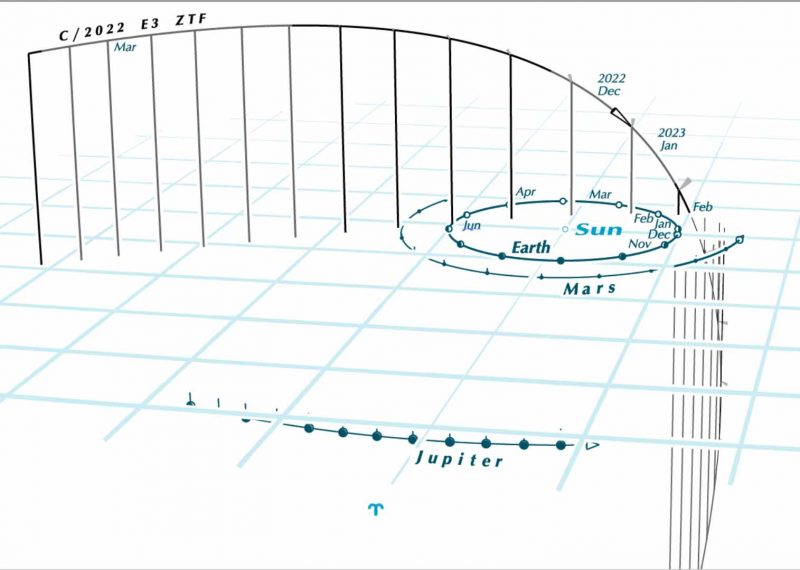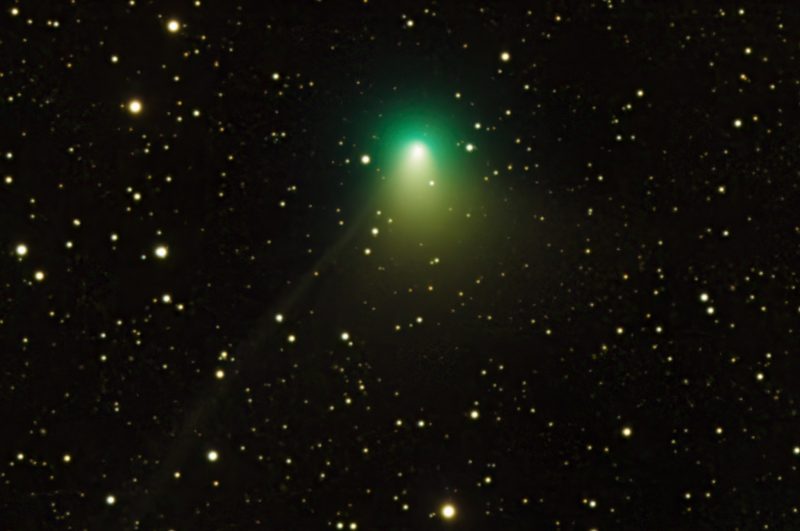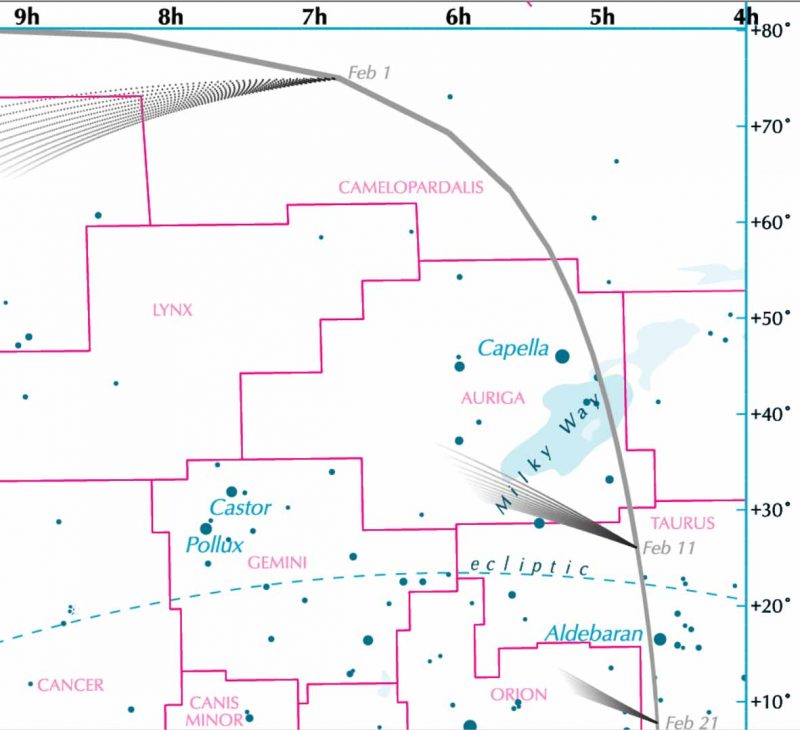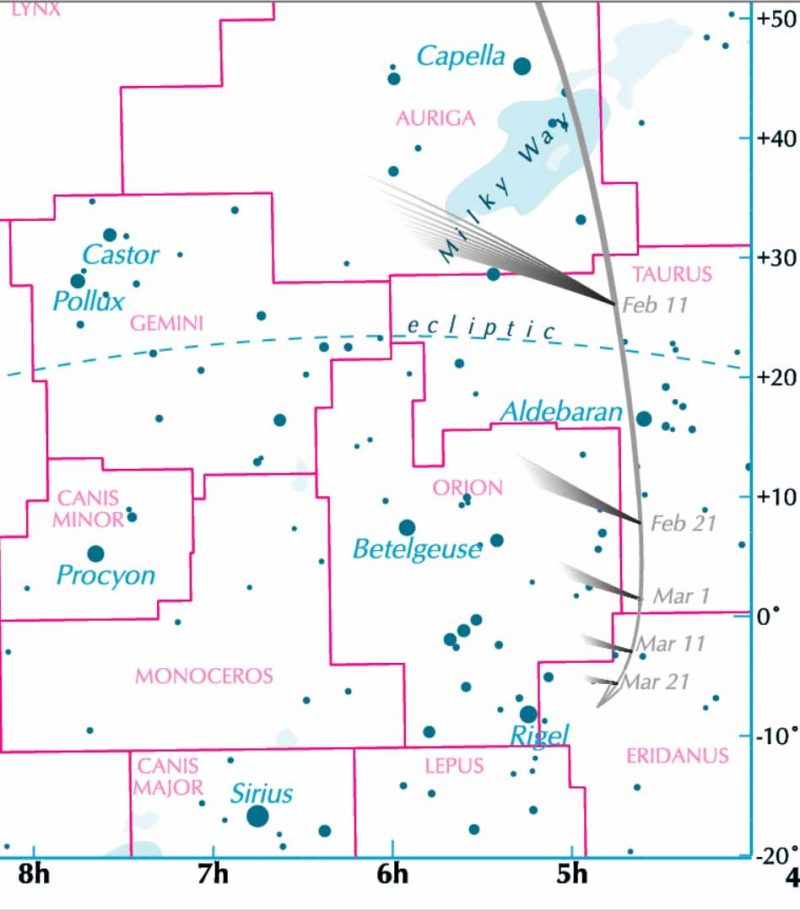
Originally published on January 15, 2023, at Guy Ottewell’s blog. Reprinted with permission.
Comet 2022 E3 ZTF: The green comet
You might have heard about the green comet C/2022 E3 ZTF.
And you might have heard astronomers say that astronomical objects rarely look green. So why is this comet green? It’s thought to be due to a reaction of diatomic carbon (C2) molecules.

The trajectory of comet 2022 E3 ZTF
The comet is called C/2022E3 (ZTF). “C” means that it is a non-periodic comet (in an orbit longer than 200 years). “E3” means it was the 3rd comet discovery (or recovery) in the first half of March. “ZTF” is its name; it was a by-product of the Zwicky Transient Facility (ZTF), a program of wide-field imaging of the sky using a camera attached to a telescope in the Palomar Observatory in California.
The astronomers who noticed the faint magnitude 17 comet were Bryce Bolin and Frank Masci. But in situations like this, it’s customary to give the comet the name of the institution.
The comet’s orbit is close to being a parabola, with a period perhaps of 50,000 years. It’s inclined by some 109 degrees to the ecliptic plane – meaning that it’s almost perpendicular but slightly retrograde – in the opposite direction to that of the planets. The perihelion, or innermost point, of the orbit is not far outside Earth’s orbit. A body in such an eccentric orbit whirls swiftly around the perihelion.
Want charts for viewing the comet? Click here.
The path of the green comet
The following charts – according to my calculations – are based on orbital elements from Harvard’s Minor Planet Center (which could change slightly as observations continue).


The comet’s history and future path
On March 2, 2022, when it was discovered, the comet was almost as distant from the sun as Jupiter; it was in the direction in our sky to the constellation Aquila the Eagle, not far north of the celestial equator and low in the morning sky. On July 8, 2022, it was at opposition, in the direction to the constellation Lyra the Harp.
Then on July 30, 2022, the comet reached a declination of about 30 degrees north, in the direction to the constellation Hercules the Hero, before curving back somewhat southward.
On November 10, 2022, it was at conjunction with the sun, but well north of it as seen on our sky’s dome, in the direction of the constellation Serpens, just south of Coma Berenices.
It was at perihelion – closest to the sun – on January 12, 2023, in Coma Berenices and at 1.11 astronomical units (AU) from the sun. It dawdled in Coma Berenices before seeming to take off northward, because Earth came around south of it.
On January 28, 2023, it will be again at opposition, far north, in the direction to Ursa Minor the Lesser Bear.
On January 30, 2023, it will be northernmost, only about 9 degrees from the north celestial pole, just above the “head” of Draco the Dragon.

The comet comes closest to Earth
In February, the comet will drop southward and will be about 0.2 AU outside Earth’s orbit; so we see it ahead of us and racing vertically south. On February 1 and 2, 2023, we will be nearest to it – at 0.29 AU – and it should be brightest then, at magnitude 5. This is comfortably within the range of the unaided eye. However, brightness predictions for comets are notoriously unreliable, because of their “behavior” of releasing dust and gas in irregular amounts and directions to form the cloud-like head and the tail as the ices of the nucleus (the tiny solid body) are heated by the sun. At this climax, the comet will be 121 degrees from the sun and very high in the evening sky.
On February 12, 2023, it will descend across the ecliptic, in Taurus. On March 2 it will be one AU away from us. Then on March 3, it will descend into the southern celestial hemisphere, its magnitude having sunk to 8. On June 20 it will be again at conjunction with the sun, well south of it, about 2.6 AU from it and 3.2 AU from Earth.
Bottom line: Learn about the trajectory of the green comet – Comet 2022 E3 ZTF – by the renowned astronomer Guy Ottewell. The comet will be closest to Earth on February 2.
Read more and find more charts: Comet 2022 E3 ZTF continues to brighten











